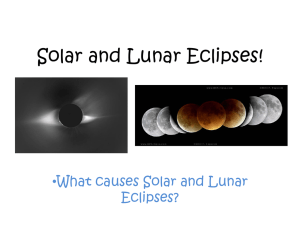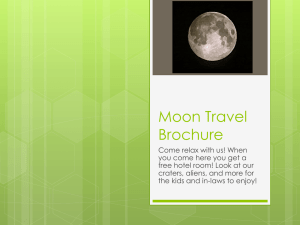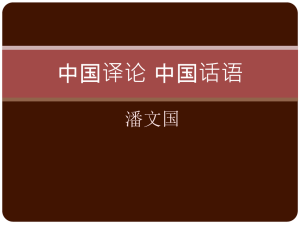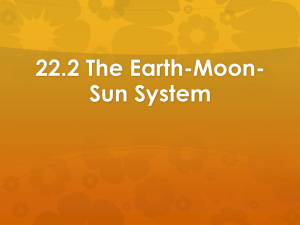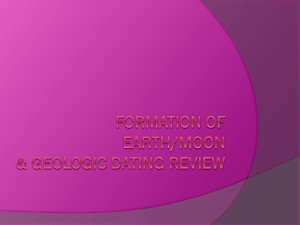SECTION27.3 The Sun-Earth
advertisement
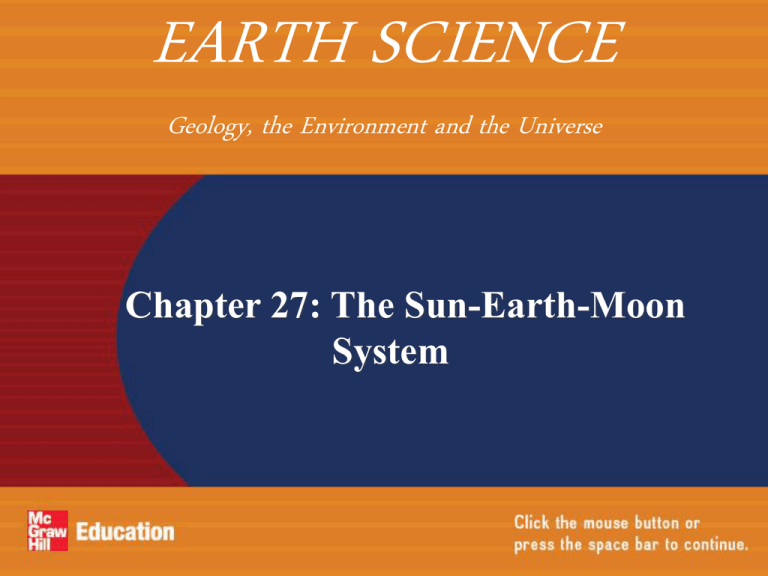
EARTH SCIENCE Geology, the Environment and the Universe Chapter 27: The Sun-Earth-Moon System CHAPTER 27 Table Of Contents Section 27.1 Tools of Astronomy Section 27.2 The Moon Section 27.3 The Sun-Earth-Moon System Click a hyperlink to view the corresponding slides. Exit SECTION 27.1 Tools of Astronomy Essential Questions • What is electromagnetic radiation? • How do telescopes work? • How does space exploration help scientists learn about the universe? SECTION 27.1 Tools of Astronomy • Radiation emitted or reflected by distant objects allows scientists to study the universe. Review Vocabulary • refraction: occurs when a light ray changes direction as it passes from one material into another SECTION 27.1 Tools of Astronomy New Vocabulary electromagnetic spectrum refracting telescope reflecting telescope interferometry SECTION Tools of Astronomy 27.1 Radiation • The radiation from bodies throughout the universe that scientists study is called electromagnetic radiation. • This includes visible light, infrared and ultraviolet radiation, radio waves, microwaves, X rays, and gamma rays. SECTION Tools of Astronomy 27.1 Radiation • The electromagnetic spectrum consists of all types of electromagnetic radiation arranged according to wavelength and frequency. SECTION Tools of Astronomy 27.1 Radiation Wavelength and frequency • Electromagnetic radiation is classified by wavelength, the distance between peaks on a wave, and frequency, the number of waves or oscillations that pass a given point per second. SECTION Tools of Astronomy 27.1 Radiation Wavelength and frequency • Frequency is related to wavelength by the mathematical relationship c = λf, where c is the speed of light (3.0 × 108 m/s), λ is the wavelength, and f is the frequency. SECTION Tools of Astronomy 27.1 Telescopes • Telescopes provide the ability to observe wavelengths beyond what the human eye can detect. They collect electromagnetic radiation from distant objects and focus it so that an image of the object can be recorded. • Telescopes can also collect light over periods of minutes or hours. SECTION Tools of Astronomy 27.1 Telescopes Refracting and reflecting telescopes • Refracting telescopes use lenses to focus visible light. SECTION Tools of Astronomy 27.1 Telescopes Refracting and reflecting telescopes • Reflecting telescopes use mirrors to focus visible light. SECTION Tools of Astronomy 27.1 Telescopes Telescopes using non-visible wavelengths • For all telescopes, the goal is to bring as much electromagnetic radiation as possible into focus. • Infrared and ultraviolet radiation can be focused by mirrors in a way similar to that used for visible light. SECTION Tools of Astronomy 27.1 Telescopes Telescopes using non-visible wavelengths • X rays cannot be focused by normal mirrors, and thus special designs must be used. • Gamma rays cannot be focused, so telescopes designed to detect this type of radiation can determine only the direction from which the rays come. SECTION Tools of Astronomy 27.1 Telescopes Telescopes using non-visible wavelengths • A radio telescope collects the longer wavelengths of radio waves with a large dish antenna and reflects them to a point above the dish. There, a receiver converts the radio waves into electric signals that can be stored in a computer for analysis. SECTION Tools of Astronomy 27.1 Telescopes Telescopes using non-visible wavelengths • The data collected from radio telescopes are converted into visual images by a computer. The image resolution can be improved using interferometry, a process that links separate telescopes so they act as one telescope, producing more detailed images as the distance between the telescopes increases. SECTION 27.1 Tools of Astronomy Space-Based Astronomy • Space-based telescopes allow astronomers to study radiation that would be blurred by our atmosphere. SECTION 27.1 Tools of Astronomy Space-Based Astronomy Hubble Space Telescope • The Hubble Space Telescope was designed to obtain sharp visible-light images without atmospheric interference and to make observations in infrared and ultraviolet wavelengths. SECTION 27.1 Tools of Astronomy Please click the image above to view the interactive table. SECTION Tools of Astronomy 27.1 Space-Based Astronomy Spacecraft • Spacecraft make observations from above Earth’s atmosphere and can also be sent directly to the bodies being observed. • Robotic probes are spacecraft that can make close-up observations and sometimes land to collect information directly. SECTION 27.1 Tools of Astronomy Space-Based Astronomy Human spaceflight • The most recent human studies have been accomplished with the space shuttle program between 1981 and 2011. • The space shuttle provides an environment for scientists to study the effects of weightlessness on humans, plants, the growth of crystals, and other phenomena. SECTION 27.1 Tools of Astronomy Space-Based Astronomy Spinoff technology • Many technologies that were originally developed for use in space programs are now used by people around the world. More than 1400 different NASA technologies, such as memory foam, have been passed on to commercial industries for common use; these are called spinoffs. SECTION Section Check 27.1 Gamma rays move through space at a greater speed than do radio waves. a. true b. false SECTION Section Check 27.1 Which objects produce the image in a refracting telescope? a. mirrors b. lamps c. lenses d. prisms SECTION 27.1 Section Check What advantage do telescopes in space have over similar instruments on Earth’s surface? a. The telescopes are closer to the object. b. The telescopes are above the atmosphere. c. The telescopes are safe from damage. d. The telescopes are always in the dark. SECTION 27.2 The Moon Essential Questions • What is the history of lunar exploration? • How are lunar properties and structures described? • What are the features of the Moon? • What is the theory of the Moon’s origin and formation? SECTION 27.2 The Moon • The Moon, Earth’s nearest neighbor in space, is unique among the moons in our solar system. Review Vocabulary • lava: magma that flows onto the surface from the interior of an astronomical body SECTION The Moon 27.2 New Vocabulary albedo highland maria impact crater ejecta ray rille regolith SECTION 27.2 The Moon Exploring the Moon • Astronomers have learned much about the Moon from observations with telescopes. However, most knowledge of the Moon comes from explorations by space probes and from landings by astronauts. SECTION 27.2 The Moon Exploring the Moon • The first step toward reaching the Moon was in 1957, when the Soviet Union launched the first artificial satellite, Sputnik I. • Four years later, Soviet cosmonaut Yuri A. Gagarin became the first human in space. SECTION 27.2 The Moon Exploring the Moon • In 1957, the United States launched the first American, Alan B. Shepard, Jr., into space during Project Mercury. • This was followed by Project Gemini that launched two-person crews. SECTION 27.2 The Moon Exploring the Moon • On July 20, 1969, the Apollo program landed Neil Armstrong and Edwin “Buzz” Aldrin on the Moon during the Apollo 11 mission. • Scientists hope to return to the Moon someday and eventually establish a permanent base there. SECTION 27.2 The Moon The Lunar Surface • The albedo of the Moon, the percentage of incoming sunlight that its surface reflects, is very small—only about 7 percent. • In contrast, Earth has an average albedo of nearly 31 percent. SECTION 27.2 The Moon The Lunar Surface • Lunar highlands are heavily cratered regions of the Moon that are light in color and mountainous. • Maria are dark, smooth plains, which average 3 km lower in elevation and have few craters. SECTION The Moon 27.2 The Lunar Surface Lunar craters • The craters on the Moon, called impact craters, formed when objects from space crashed into the lunar surface. • The material blasted out during these impacts fell back to the Moon’s surface as ejecta. SECTION The Moon 27.2 The Lunar Surface Lunar craters • Some craters have long trails of ejecta, called rays, that radiate outward from the impact site. • Rilles are meandering structures that might be collapsed lava tubes. SECTION The Moon 27.2 The Lunar Surface Lunar properties • Earth’s moon is unique among all the moons in the solar system. It is the largest moon compared to the radius and mass of the planet it orbits. It is a solid, rocky body, in contrast with the icy compositions of most other moons of the solar system. SECTION The Moon 27.2 The Lunar Surface Lunar properties • The Moon’s orbit is farther from Earth relative to the distance of many moons from the planets they orbit. SECTION The Moon 27.2 The Lunar Surface Lunar properties • The Moon is made up of minerals similar to those of Earth—mostly silicates. • The highlands are mostly lunar breccias, which are rocks formed by the fusion of smaller rocks during impacts. The maria are predominantly basalt that contains no water. SECTION 27.2 The Moon Please click the image above to view the interactive table. SECTION 27.2 The Moon History of the Moon • The Moon is approximately 3.8 to 4.6 billion years old, about the same age as Earth. • Scientists theorize that the Moon was heavily bombarded during its first 800 million years. This caused the breaking and heating of surface rocks and resulted in a layer of loose, ground-up rock called regolith on the surface. SECTION The Moon 27.2 History of the Moon Layered structure • Scientists infer from seismic data that the Moon, like Earth, has a layered structure, which consists of the crust, upper mantle, lower mantle, and core. SECTION 27.2 The Moon History of the Moon Formation of maria • After the period of intense bombardment that formed the highlands, lava welled up from the Moon’s interior and filled in the large impact basins. • This lava fill created the dark, smooth plains of the maria. SECTION The Moon 27.2 History of the Moon Tectonics • Scientists think that the Moon is not tectonically active because the Moon has no active volcanoes and no significant magnetic field. SECTION The Moon 27.2 Formation • The Moon probably formed as the result of a collision between Earth and a Mars-sized object about 4.5 bya when the solar system was forming. SECTION The Moon 27.2 Formation • The impact theory of the Moon’s formation states that material ejected from Earth and from the striking object eventually merged to form the Moon. SECTION 27.2 The Moon Please click the image above to view the video. SECTION Section Check 27.2 The Moon has a lower density than that of Earth. a. true b. false SECTION Section Check 27.2 Which term refers to meandering structures on the Moon that might be lava tubes? a. ejecta b. rays c. rilles d. highlands SECTION 27.2 Section Check Which theory about how the Moon formed is most accepted? a. The Moon was captured by Earth. b. The Moon condensed with Earth. c. A Mars-sized object struck Earth. d. A piece broke off of Earth. SECTION 27.3 The Sun-Earth-Moon System Essential Questions • What are the relative positions and motions of the Sun, Earth, and Moon? • What are the phases of the Moon? • What are the differences between solstices and equinoxes? • How are eclipses of the Sun and Moon explained? SECTION 27.3 The Sun-Earth-Moon System • Motions of the Sun-Earth-Moon system define Earth’s day, month, and year. Review Vocabulary • revolution: the time it takes for a planetary body to make one orbit around another, larger body SECTION 27.3 The Sun-Earth-Moon System New Vocabulary ecliptic plane solstice equinox synchronous rotation solar eclipse perigee apogee lunar eclipse SECTION 27.3 The Sun-Earth-Moon System Daily Motions • The Sun, the Moon, planets, and stars do not orbit around Earth every day. It appears that way because we observe the sky from a planet that rotates. SECTION 27.3 The Sun-Earth-Moon System Daily Motions Earth’s rotation • Both a Foucault pendulum and the Coriolis effect demonstrate that Earth is rotating. SECTION 27.3 The Sun-Earth-Moon System Daily Motions Earth’s rotation • The time period from one noon to the next is called a solar day. As Earth rotates, it moves in its orbit and has to turn a little farther each day to align with the Sun. SECTION 27.3 The Sun-Earth-Moon System Annual Motions • Earth orbits the Sun in a slightly elliptical orbit. The plane of Earth’s orbit is called the ecliptic plane. SECTION 27.3 The Sun-Earth-Moon System Annual Motions The effects of Earth’s tilt • Earth’s axis is tilted relative to the ecliptic at approximately 23.5. As Earth orbits the Sun, the orientation of Earth’s axis remains fixed. SECTION 27.3 The Sun-Earth-Moon System Annual Motions The effects of Earth’s tilt • Earth’s tilt and orbital motion around the Sun result in a cycle of the seasons. • Another effect is the changing angle of the Sun above the horizon from summer to winter. SECTION 27.3 The Sun-Earth-Moon System Annual Motions The effects of Earth’s tilt • At a solstice, the Sun is overhead at its farthest distance either north or south of the equator. • The lines of latitude that correspond to these positions on Earth have been identified as the Tropic of Cancer and the Tropic of Capricorn. SECTION 27.3 The Sun-Earth-Moon System Annual Motions The effects of Earth’s tilt • The summer solstice occurs in the northern hemisphere when the Sun is directly overhead at the Tropic of Cancer, 23.5 north latitude. SECTION 27.3 The Sun-Earth-Moon System Annual Motions The effects of Earth’s tilt • The winter solstice occurs in the northern hemisphere when the Sun is directly overhead at the Tropic of Capricorn, 23.5 south latitude. SECTION 27.3 The Sun-Earth-Moon System Annual Motions The effects of Earth’s tilt • At an equinox, Earth’s axis is perpendicular to the Sun’s rays and at noon the Sun is directly overhead at the equator. SECTION 27.3 The Sun-Earth-Moon System Annual Motions The effects of Earth’s tilt • The Sun’s maximum height, called its zenith, varies throughout the year depending on the viewer’s location. SECTION 27.3 The Sun-Earth-Moon System Annual Motions The effects of Earth’s tilt • For a person standing on the 23.5 north latitude, the Sun would be at zenith on the summer solstice. It would be at its lowest position at the winter solstice. SECTION 27.3 The Sun-Earth-Moon System Phases of the Moon • The Moon changes position relative to the ecliptic plane as it orbits Earth. SECTION 27.3 The Sun-Earth-Moon System Phases of the Moon Waxing and waning • Starting at the new moon, as the Moon moves in its orbit around Earth, more of the sunlit side of the Moon becomes visible. This increase in the visible sunlit surface of the Moon is called the waxing phase. SECTION 27.3 The Sun-Earth-Moon System Phases of the Moon Waxing and waning • The waxing phases are called waxing crescent, first quarter, and waxing gibbous. • As the Moon moves to the far side of Earth from the Sun, the entire sunlit side of the Moon faces Earth. This is known as a full moon. SECTION 27.3 The Sun-Earth-Moon System Phases of the Moon Waxing and waning • After the full moon, the portion of the sunlit side that is visible begins to decrease. This is called the waning phase. The waning phases are waning gibbous and waning crescent. When exactly half of the sunlit portion is visible, it is called the third quarter. SECTION 27.3 The Sun-Earth-Moon System Visualizing the Phases of the Moon • One-half of the Moon is always illuminated by the Sun’s light, but the entire lighted half is visible from Earth only at full moon. The rest of the time you see portions of the lighted half. These portions are called lunar phases. SECTION 27.3 The Sun-Earth-Moon System Please click the image above to view the video. SECTION 27.3 The Sun-Earth-Moon System Phases of the Moon Synchronous rotation • The state at which the Moon’s orbital and rotational periods are equal is called synchronous rotation. SECTION 27.3 The Sun-Earth-Moon System Lunar Motions • The length of time it takes for the Moon to go through a complete cycle of phases is called a lunar month. SECTION 27.3 The Sun-Earth-Moon System Lunar Motions • The length of a lunar month is about 29.5 days, which is longer than the 3 days it takes for one revolution, or orbit, around Earth. SECTION 27.3 The Sun-Earth-Moon System Lunar Motions • The Moon rotates as it revolves, keeping the same side facing Earth. SECTION The Sun-Earth-Moon System 27.3 Lunar Motions Tides • The Moon’s gravity pulls on Earth along an imaginary line connecting Earth and the Moon, and this creates bulges of ocean water on both the near and far sides of Earth. SECTION The Sun-Earth-Moon System 27.3 Lunar Motions Tides • Alignment of the Sun and the Moon produces the spring tides, shown on the left. • Neap tides, shown on the right, occur when the Sun and the Moon are at right angles. SECTION 27.3 The Sun-Earth-Moon System Solar Eclipses • A solar eclipse occurs when the Moon passes directly between the Sun and Earth and blocks the Sun from view. SECTION 27.3 The Sun-Earth-Moon System Solar Eclipses How solar eclipses occur • During a solar eclipse, the Moon passes between Earth and the Sun. Those on Earth within the darkest part of the Moon’s shadow (umbra) see a total eclipse. Those within the lighter part, or penumbral shadow, see only a partial eclipse. SECTION 27.3 The Sun-Earth-Moon System Please click the image above to view the video. SECTION 27.3 The Sun-Earth-Moon System Solar Eclipses How solar eclipses occur • Solar eclipses can take place only when Earth, the Moon, and the Sun are perfectly aligned. SECTION 27.3 The Sun-Earth-Moon System Solar Eclipses How solar eclipses occur • Solar eclipses can happen only when the Moon’s orbital plane and ecliptic plane intersect along the Sun-Earth line, shown on the right. In the left diagram, this does not happen, and the Moon’s shadow misses Earth. SECTION 27.3 The Sun-Earth-Moon System Solar Eclipses How solar eclipses occur • The closest point in the Moon’s orbit to Earth is called perigee. • The farthest point is called apogee. • An annular eclipse takes place when the Moon is too far away for its umbral shadow to reach Earth. SECTION 27.3 The Sun-Earth-Moon System Lunar Eclipses • A lunar eclipse occurs when the Moon passes through Earth’s shadow. • A total lunar eclipse occurs when the entire Moon is within Earth’s umbra. This lasts for approximately two hours. SECTION 27.3 The Sun-Earth-Moon System Lunar Eclipses • Lunar eclipses do not occur every full moon because the Moon in its orbit usually passes above or below the Sun as seen from Earth. SECTION Section Check 27.3 How much time elapses between one moon rise and the next moon rise? a. 24 hours b. 25 hours c. 23 hours 10 minutes d. 24 hours 50 minutes SECTION Section Check 27.3 Which location on Earth receives sunlight at the highest angle on the day of the northern hemisphere summer solstice? a. the equator b. the Tropic of Cancer c. the Tropic of Capricorn d. the Arctic Circle SECTION Section Check 27.3 What lunar phase appears when Earth is between the Sun and Moon? a. full moon b. new moon c. first quarter d. third quarter CHAPTER 27 The Sun-Earth-Moon System Resources Earth Science Online Study Guide Chapter Assessment Questions Standardized Test Practice Click on a hyperlink to view the corresponding feature. SECTION Tools of Astronomy 27.1 Study Guide • Radiation emitted or reflected by distant objects allows scientists to study the universe. • Telescopes collect and focus electromagnetic radiation emitted or reflected from distant objects. • Electromagnetic radiation is classified by wavelength and frequency. SECTION Tools of Astronomy 27.1 Study Guide • The two main types of optical telescopes are refractors and reflectors. • Space-based astronomy includes the study of orbiting telescopes, satellites, and probes. • Technology originally developed to explore space is now used by people on Earth. SECTION The Moon 27.2 Study Guide • The Moon, Earth’s nearest neighbor in space, is unique among the moons in our solar system. • Astronomers have gathered information about the Moon using telescopes, space probes, and astronaut exploration. • Like Earth’s crust, the Moon’s crust is composed mostly of silicates. SECTION The Moon 27.2 Study Guide • Surface features on the Moon include highlands, maria, ejecta, rays, and rilles. It is heavily cratered. • The Moon probably formed about 4.5 bya in a collision between Earth and a Mars-size object. SECTION 27.3 The Sun-Earth-Moon System Study Guide • Motions of the Sun-Earth-Moon system define Earth’s day, month, and year. • Earth’s rotation defines one day, and Earth’s revolution around the Sun defines one year. • Seasons are caused by the tilt of Earth’s spin axis relative to the ecliptic plane. SECTION 27.3 The Sun-Earth-Moon System Study Guide • The gravitational attraction of both the Sun and the Moon causes tides. • The Moon’s phases result from our view of its lighted side as it orbits Earth. • Solar and lunar eclipses occur when the Sun’s light is blocked. CHAPTER 27 The Sun-Earth-Moon System Chapter Assessment Which type of electromagnetic radiation has the shortest wavelength? a. radio waves b. ultraviolet rays c. infrared waves d. gamma rays CHAPTER 27 The Sun-Earth-Moon System Chapter Assessment Examine the illustration. Which layer of the Moon is shown by the letter C? a. the lower mantle C B D b. the upper mantle c. the core d. the crust A CHAPTER 27 The Sun-Earth-Moon System Chapter Assessment During which lunar phase could a solar eclipse occur? a. new moon b. full moon c. first quarter d. third quarter CHAPTER 27 The Sun-Earth-Moon System Chapter Assessment How did the maria on the Moon’s surface form? a. The Moon’s crust was stretched. b. Water transported sediment into basins. c. Regolith fell on the lunar surface. d. Volcanic eruptions filled impact craters. CHAPTER 27 The Sun-Earth-Moon System Chapter Assessment Why are lunar phases seen from Earth? Answer: Half of the Moon is always lighted by sunlight. As the Moon revolves around Earth, different amounts of the near side of the Moon, which always faces Earth, are illuminated. CHAPTER 27 The Sun-Earth-Moon System Standardized Test Practice During which moon phases do spring tides occur? a. first quarter and full moon b. new moon and third quarter c. full moon and new moon d. first quarter and third quarter CHAPTER 27 The Sun-Earth-Moon System Standardized Test Practice How old are the lunar highlands? a. between 1.2 and 1.7 billion years b. between 2.3 and 2.9 billion years c. between 3.8 and 4.6 billion years d. between 5.1 and 5.9 billion years CHAPTER 27 The Sun-Earth-Moon System Standardized Test Practice Examine the illustration. Which season is occurring in the northern hemisphere? a. summer b. autumn c. winter d. spring CHAPTER 27 The Sun-Earth-Moon System Standardized Test Practice How does the plane of the Moon’s orbit compare to the ecliptic? a. It is the same as the ecliptic. b. It is tilted 5 degrees to the ecliptic. c. It is tilted 10 degrees to the ecliptic. d. It is tilted 25 degrees to the ecliptic. CHAPTER 27 The Sun-Earth-Moon System Standardized Test Practice How is a lunar eclipse different from a solar eclipse? CHAPTER 27 The Sun-Earth-Moon System Standardized Test Practice Answer: A lunar eclipse is an eclipse of the Moon. During a lunar eclipse, Earth blocks sunlight from striking all or part of the Moon’s surface. The eclipse can be seen by anyone on Earth who can see the Moon. A solar eclipse is an eclipse of the Sun. During a solar eclipse, the Moon blocks some or all sunlight from reaching a portion of Earth. The eclipse can be seen by only the people in the affected region.





